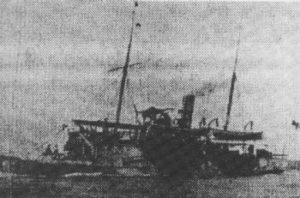- Author
- Wilson, Graham, Warrant Officer Class Two, Australian Intelligence Corps
- Subjects
- Colonial navies, History - pre-Federation
- Tags
-
- RAN Ships
- HMAS Gayundah
- Publication
- June 1996 edition of the Naval Historical Review (all rights reserved)
HMAS Gayundah

(Photo-Steve Given)
Gayundah, however, was another matter. Designed as a gunboat, that is exactly what she became. Weighing 360 tons, the ship was 120 ft (36.57 m) long with a beam of 26 ft (7.92 m) and drew 9½ ft (2.89 m). As completed she was armed with one 8 in (203 mm) gun forward, one 6 m (152 mm) gun aft and four 1.5 in (38 mm) Nordenfeldts. With a bunker capacity of 75 tons of coal she had an economical cruising range of 800 miles and carried a complement of 55.
To command Gayundah, and the rest of the Queensland Marine Defence Force for that matter, Queensland secured the services of Commander Henry Townley Wright, an experienced officer who had joined the Royal Navy in 1859. and had seen extensive service afloat and ashore in China (where he received a mention in despatches for his services during the China War and later took part in the Perak Expedition) and in Africa where he held various appointments on the Cape of Good Hope Station and received another mention in despatches for service with the Naval Brigade during the Kaffir War. Commander Wright had been forced by age to retire on half-pay in 1881 and jumped at the chance of commanding the Queensland navy. For its part, the Queensland government congratulated itself on securing the services of such a distinguished and highly decorated officer. Unfortunately their delight was eventually to be proved to be misplaced, as will be seen.
Commander Wright sailed with his command from Newcastle on 13 November 1884 bound for Gibraltar. From Gibraltar Gayundah steamed across the Mediterranean to Malta which was reached on 9 December. Bad weather on the way had forced Gayundah to shelter in Algiers for four days and resulted in her having to go into dry dock for repairs for three weeks at Malta. Commander Wright took the opportunity of attending a course on the Whitehead torpedo while his ship was in dock. Gayundah left Malta on 30 December, bound for Queensland via the Suez Canal with coaling stops at Aden, Colombo, Batavia, Thursday Island and Townsville. At the first three ports Gayundah took on extra coal as deck cargo to ensure that she had adequate fuel for longer ocean legs of her voyage. She eventually reached Brisbane on 27 March 1885 after a voyage of 134 days of which about 95 days were spent at sea, a fairly creditable record of seamanship and endurance.
Unfortunately for the crew, there was to be no rest following their long voyage as Gayundah arrived right in the middle of another Russian war scare and was immediately ordered to take part in joint naval and military manoeuvres then under way around Brisbane. Both the ship and her crew performed very well during the manoeuvres, Gayundah proving herself to be particularly well suited to operation in the estuarine waters around Brisbane. At the end of manoeuvres on 7 April, Gayundah was finally able to go into South Brisbane Dock for a much needed clean and overhaul. She came out of dock on 10 April and entered into a round of coastal patrols and piquet duty until the war scare finally subsided in mid-May.
Lieutenant Hesketh’s Unbecoming Conduct
Following the great Russian scare, Gayundah settled down to a routine of training cruises and inspections, managing to lead a very quiet life for a couple of years. During this period, Commander Wright apparently expanded much energy in ensuring that both his ship and its men and those of the rest of his small command, both regular and reserve, reached as high a level of efficiency as possible. Then, in 1887, the court martial of Lieutenant Spencer Hesketh upset the quiet and ordered existence of the Queensland Marine Defence Force.
Lieutenant Hesketh had been commissioned into the Queensland Marine Defence Force in 1885 and was employed as First Lieutenant of Gayundah. Hesketh was apparently either not a good money manager or was somewhat profligate in his life style as by the early months of 1887 he was in severe financial difficulties. While this had been developing for some time, Commander Wright was either not aware of it or was prepared to turn a blind eye to it until such time as he was no longer able to ignore it. This occurred when Hesketh borrowed £10 from a seaman and issued a bad cheque in return.




